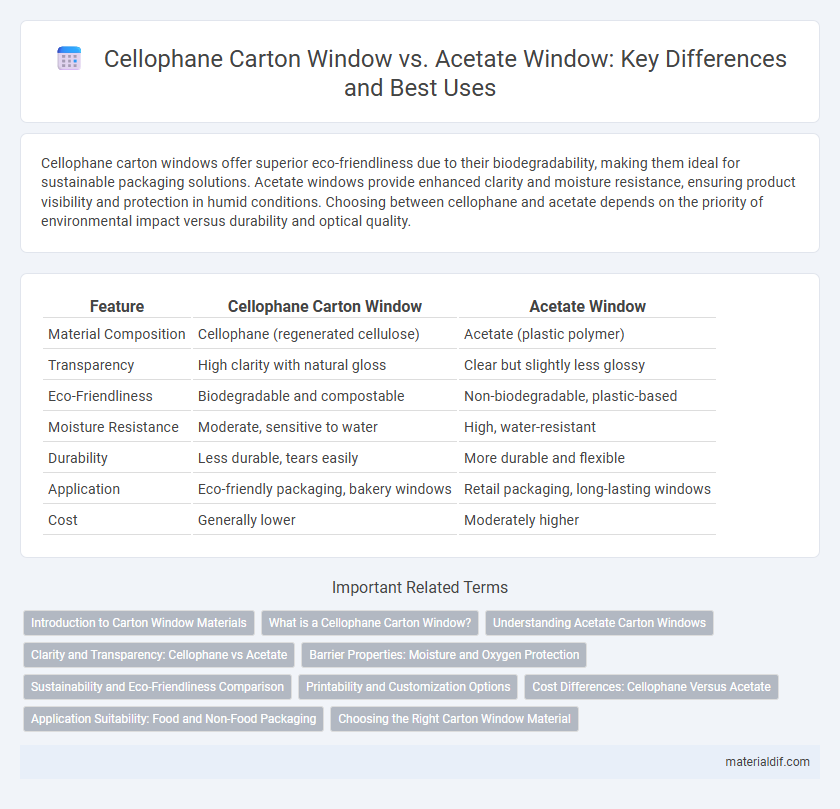Cellophane carton windows offer superior eco-friendliness due to their biodegradability, making them ideal for sustainable packaging solutions. Acetate windows provide enhanced clarity and moisture resistance, ensuring product visibility and protection in humid conditions. Choosing between cellophane and acetate depends on the priority of environmental impact versus durability and optical quality.
Table of Comparison
| Feature | Cellophane Carton Window | Acetate Window |
|---|---|---|
| Material Composition | Cellophane (regenerated cellulose) | Acetate (plastic polymer) |
| Transparency | High clarity with natural gloss | Clear but slightly less glossy |
| Eco-Friendliness | Biodegradable and compostable | Non-biodegradable, plastic-based |
| Moisture Resistance | Moderate, sensitive to water | High, water-resistant |
| Durability | Less durable, tears easily | More durable and flexible |
| Application | Eco-friendly packaging, bakery windows | Retail packaging, long-lasting windows |
| Cost | Generally lower | Moderately higher |
Introduction to Carton Window Materials
Cellophane carton windows offer a biodegradable and transparent option that enhances product visibility while maintaining eco-friendly packaging standards. In contrast, acetate windows provide superior clarity and moisture resistance, making them ideal for products requiring higher durability. Choosing between cellophane and acetate depends on balancing environmental impact with performance needs in carton window applications.
What is a Cellophane Carton Window?
A cellophane carton window is a transparent film made from regenerated cellulose used in packaging to provide clear visibility of the product inside while maintaining breathability. It offers superior biodegradability and compostability compared to acetate windows, making it an eco-friendly choice for sustainable packaging. Cellophane windows also have excellent moisture resistance and clarity, enhancing product appeal without compromising environmental impact.
Understanding Acetate Carton Windows
Acetate carton windows offer superior clarity and durability compared to cellophane windows, providing enhanced product visibility and protection. Unlike cellophane, acetate is moisture-resistant and less prone to fogging, making it ideal for packaging that requires long shelf life and clear display. This material also supports easier printing and customization, enhancing overall package appeal and consumer engagement.
Clarity and Transparency: Cellophane vs Acetate
Cellophane carton windows offer superior clarity and higher transparency compared to acetate windows, ensuring clearer product visibility. Cellophane's natural cellulose structure minimizes light distortion, resulting in a bright, glass-like appearance. Acetate windows, while flexible, tend to have a slight haze that can reduce the sharpness of the displayed product.
Barrier Properties: Moisture and Oxygen Protection
Cellophane carton windows offer moderate moisture protection but are less effective against oxygen penetration compared to acetate windows, which provide superior barrier properties for both moisture and oxygen. Acetate windows enhance product freshness and shelf life by significantly reducing permeability, making them ideal for packaging sensitive goods. The choice between cellophane and acetate windows depends on the required protection level, with acetate preferred for high-barrier packaging needs.
Sustainability and Eco-Friendliness Comparison
Cellophane carton windows are biodegradable and compostable, making them a highly sustainable option compared to acetate windows, which are typically petroleum-based and non-biodegradable. Cellophane is derived from renewable wood pulp, reducing environmental impact and promoting eco-friendliness in packaging. In contrast, acetate windows contribute to plastic waste and have a longer decomposition period, making them less ideal for sustainable packaging solutions.
Printability and Customization Options
Cellophane carton windows provide superior printability and customization options compared to acetate windows, allowing for vibrant, high-resolution graphics directly on the packaging surface. Cellophane's natural clarity enhances visual appeal while enabling a variety of finishes, including matte, glossy, or textured effects, tailored to specific brand requirements. Acetate windows, though clear, offer limited print compatibility and customization, often requiring overlays or additional printing steps that can increase production complexity and cost.
Cost Differences: Cellophane Versus Acetate
Cellophane cartons typically cost less than acetate window cartons due to the lower production expenses of cellophane, which is derived from renewable cellulose sources, making it more eco-friendly and economical. Acetate, being a synthetic polymer, involves higher manufacturing costs and more complex processing, resulting in a pricier product for packaging applications. Overall, cellophane offers a cost-effective alternative for windowed cartons without compromising transparency and consumer appeal.
Application Suitability: Food and Non-Food Packaging
Cellophane carton windows provide superior breathability and biodegradability, making them highly suitable for fresh food packaging where moisture control and eco-friendliness are priorities. Acetate windows offer greater clarity and durability, preferred in non-food packaging such as cosmetics and gift boxes that require a premium appearance and long shelf life. Both materials ensure visibility of the product, but cellophane's natural properties align better with perishable food items, while acetate excels in applications demanding enhanced strength and aesthetic appeal.
Choosing the Right Carton Window Material
Choosing the right carton window material depends on the desired clarity, durability, and environmental impact of the packaging. Cellophane carton windows offer superior biodegradability and a natural, glossy finish, making them ideal for eco-conscious brands seeking transparent yet sustainable solutions. In contrast, acetate windows provide higher moisture resistance and flexibility but are less environmentally friendly, often used when product protection and visual clarity under humid conditions are priorities.
Cellophane Carton Window vs Acetate Window Infographic

 materialdif.com
materialdif.com